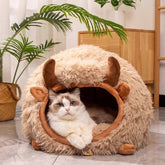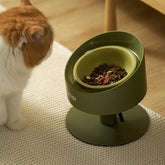The Hidden Danger in Your Home: 10 Common House Plants That Harm Cats & Safe Substitutes You Must Know

As a caring cat owner, you know how much your feline friends love to explore, play, and occasionally nibble on the greenery in your home. But, are you sure that every plant within their reach is a safe plant for cats? Today, we'll shed some light on the truth about house plants that are far from being cat-friendly while also recommending some excellent alternatives.
Identifying the Threat of Toxic House Plants

Unbeknownst to many, certain common house plants can cause significant health problems in cats. When curious kittens eat them, they might suffer from symptoms ranging from mild irritation to severe toxicity, even death.
Among the most common house plants dangerous to cats are:
- Lilies: Almost all types can cause severe kidney failure.
- Aloe Vera: While beneficial for humans, it can lead to vomiting, diarrhea, and tremors in cats.
- English Ivy: Known to cause vomiting, abdominal pain, drooling, and diarrhea.
- Dieffenbachia: Causes oral irritation, difficulty in swallowing, and excessive drooling.
- Tulips: The toxic part is the bulb, which can cause oral irritation, excessive drooling, and nausea.
- Azaleas: Even a few leaves can result in vomiting, diarrhea, and excessive drooling.
- Daffodils: Bulbs are the most toxic part, causing vomiting, diarrhea, and possibly leading to cardiac arrhythmia.
- Cyclamen: The root is especially dangerous, causing severe vomiting and even death.
- Rhododendrons: Can result in vomiting, diarrhea, drooling, and a drop in blood pressure.
- Oleander: Gastrointestinal tract irritation, abnormal heart function, hypothermia, and even death.

If you notice any abnormal behavior or symptoms in your cat after they have ingested any toxic house plants, it is important to act quickly. Here are some signs to look out for:
- Vomiting: Cats may vomit as a result of ingesting a toxic plant. If your cat is vomiting repeatedly or showing signs of distress, it is a cause for concern.
- Diarrhea: Changes in bowel movements, such as diarrhea, can indicate that your cat is experiencing gastrointestinal issues due to plant toxicity.
- Excessive drooling: Excessive drooling or foaming at the mouth can be a sign of oral irritation or poisoning.
- Difficulty in breathing: If your cat is having difficulty breathing or showing signs of respiratory distress, it may be a result of a severe reaction to a toxic plant.
- Lethargy: A sudden lack of energy or unusual tiredness in your cat could be a symptom of plant toxicity.
- Loss of appetite: If your cat refuses to eat or shows a significant decrease in appetite, it may be a sign of illness or poisoning.
- Abnormal heart rate: An irregular or rapid heartbeat can indicate a serious reaction to a toxic plant.
If you observe any of these symptoms or suspect that your cat has ingested a toxic plant, it is crucial to consult your veterinarian immediately. Early detection and prompt treatment can make a significant difference in the outcome for your cat's health.
Greener Pastures: Introducing Cat-Friendly House Plants

Now that we've shared the shocking truth about some of the best house plants, let's switch gears and talk about the greenery that offers safety and peace of mind. Here is a list of cat-friendly house plants:
- Spider Plant: A safe and easy-to-maintain indoor plant.
- Bamboo Palm: Safe for cats and purifies indoor air.
- Areca Palm: Non-toxic and beats the indoor air purifier by removing harmful toxins.
- Boston Fern: Safe for cats and adds a tropical touch to your home.
- Blue Echeveria: A beautiful succulent that’s completely safe for your cats.
- Swedish Ivy: Known for its rapid growth and easy maintenance.
- Barberton Daisy: Brightly colored, safe for cats, and purifies the air.
- Lipstick Plant: Its cat-safe leaves and flowers make it a perfect house plant.
- Christmas Cactus: Despite its name, it's not prickly and is absolutely safe for cats.
- Catnip: While it may cause a mild euphorics in cats, it's entirely harmless.

By adding these cat-friendly house plants to your home, you can strike the right balance between fulfilling your green thumb ambitions and maintaining a stylish, safe, and modern space for your feline companion. At the same time, you can keep the air in your home fresh and purified, making cat care truly effortless. Now that's what we call a win-win situation!























